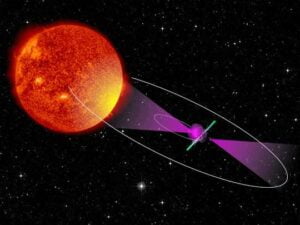Project area/S
- Fast Transients & Pulsars
Project Details
Pulsars in binary systems are exciting laboratories for wide-ranging physics and astrophysics, including performing exquisite tests of general relativity and measuring the masses of neutron stars. With the recent data release from the GAIA Space Observatory (Gaia DR3), it is now possible to search for astrometric signatures of binary motion from the billions of catalogued stars. This offers exciting new avenues for discovering new types of pulsar binary systems with massive and/or main-sequence stellar companions. Such systems are likely to be rare, but they can provide some of the best probes of stellar winds. This project will involve exploiting the Gaia DR3 data set for identifying promising candidate sources which can then be followed up using high-time resolution data sets from the ongoing Southern-sky MWA Rapid Two-metre (SMART) pulsar survey with the Murchison Widefield Array (MWA). The SMART survey exploits the large field of view and voltage-capture capabilities of MWA to search for pulsars and fast transients in the southern sky. The project will undertake sensitive pulsar searches toward promising targets from the Gaia analysis, and holds the potential to make the first discoveries of binary pulsar systems with the MWA
Student Attributes
Academic Background
Enrollment in any Physics course is appropriate, with interest in observational astrophysics and the related computing and data processing aspects.
Computing Skills
Linux/Unix operating systems, Python
Training Requirement
Using supercomputing systems
Project Timeline
- Week 1 Inductions and project introduction
- Week 2 Initial Presentation
- Week 3 Familiarize with pulsars, pulsar binary systems, and why pulsar-main sequence binaries are interesting
- Week 4 Familiarize with the Gaia DR3 catalogue and how to navigate through it
- Week 5-6 Develop criteria that can be used to select promising candidates based on their likelihood of binarity and refine to manageable list
- Week 7-8 Process MWA high-time resolution data and search for pulsations (via single pulse, FFT, FFA search)
- Week 9 Final Presentation
- Week 10 Final Report

An Artist’s impression of a binary stellar system with a pulsar and massive stellar companion.
